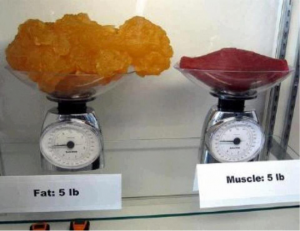A Pound of Feathers
Which weighs more, a pound of feathers or a pound of bricks?
As kids we may have been to naïve to think that a brick and a feather could weigh the same, but the reality we all embrace is that a pound will always equal a pound. The same logic holds true when you consider the ‘muscle weighs more than fat’ argument. I hear this one all the time from both patients and professionals alike that the reason they are not losing any weight is because they have so much muscle and since it weighs MORE than fat, losing weight is simply harder to do.
Well, no. Not really. Not even a little bit. A pound of muscle is equal to a pound of fat. No doubt about it. The truth is that Muscle has a much greater density than fat, meaning it takes up less volume than an equal mass of fat. This explains why it’s possible to get visibly slimmer without a significant drop in weight.
 When trying to fight the battle of the bulge, something to always consider is appearance and the way clothes fit, rather than a number on a scale.
When trying to fight the battle of the bulge, something to always consider is appearance and the way clothes fit, rather than a number on a scale.
It’s possible to look and feel trimmer even if body weight remains the same. Of course, it’s also possible to weigh the same, but look and feel fatter. This is especially evident among the elderly, as muscles tend to shrink with age because damaged muscle cells are repaired at a much slower rate than when they were young. When you factor in reduced physical activity, as we get older, the ratio of muscle to fat tends to decrease.
The bottom line is what we all know already. Too much fat can lead to increase risk for coronary diseases, strokes and diabetes. Determining your target for your ideal muscle to fat ratio can be challenging. Too little fat can cause reproductive dysfunction in woman. Ultimately, we need to find a balance that fits our own needs. So while the hours on the treadmill or at cross fit don’t seem to be making the numbers diminish on that fancy scale you splurged on, use the old fashioned method of a mirror and a notebook that can track your gains in strength and stamina. You will be certain to see the very best you have to offer.
Ready to #feelbetter?
You're just a click away from a wicked good massage!
-

60 Minute Massage Gift Card
$170.00 Add to cart -

90 Minute Massage Gift Card
$255.00 Add to cart -

Mini Aer Small Room Air Purifier
$149.00 Add to cart -
Sale!

Thera-Pearl Sports Pack/Hot Cold
Original price was: $14.99.$12.99Current price is: $12.99. Add to cart -

3 Somadome Sessions Gift Card
$135.00 Add to cart -

20 Minute Somadome Gift Card
$45.00 Add to cart -
Sale!

TheraBand® Stretch Strap
Original price was: $19.99.$14.99Current price is: $14.99. Add to cart -

TheraBand CLX Connective Loop
$14.99 Select options
Muscle Strains
A strain, sometimes referred to as a pulled muscle, is a muscle injury produced by excessive tensile stress that causes fibers to tear within the tissue. A muscle strain does not usually result from excess stretch alone, but from a combination of tension and contraction. Muscle strains can develop when excess tension is placed on…
Read MoreShin Splints or Compartment Syndrome?
One of the most common overuse injuries affecting the lower extremity is the condition known as shin splints. While the term shin splints routinely is used, especially among the athletic population, it does not represent a specific clinical pathology. Instead, it describes chronic shin pain resulting from overuse. It occurs in two regions of the…
Read MoreAn Alternative Approach to Stretching
Clinicians, athletes and rehabilitation specialists advocate stretching as a means for injury prevention and treatment. The primary purpose of any stretching technique is to enhance pliability and flexibility in the soft tissues. It is also routinely incorporated with massage in the treatment of pain and injury conditions. There are many different stretching techniques, which all…
Read MoreGanglion Cysts
The highly refined palpation skills of massage practitioners are such that we often identify tissue abnormalities before the client is aware of them. An indication that we should refer a patient for further evaluation is when we identify something we aren’t sure of but know shouldn’t normally be there. One such example may occur with…
Read MoreWhat Is the “End Feel”?
Some of the most valuable assessment information is derived from relatively simple procedures such as passive range-of-motion tests. While many massage practitioners have been exposed to the fundamental concepts of active and passive range-of-motion testing, most have not learned how to use this information effectively in a clinical environment. In this article, we will focus…
Read MoreHow Accurate Is That Test?
Physical assessment is considered one of the most accurate ways to assess function of the locomotor tissues of the body. While we can often gain valuable information about structural problems through high-tech diagnostic procedures like X-ray or MRI, these procedures tell us very little about the function of the tissues involved in creating and limiting…
Read MoreWhen Is It Tendinitis?
Tendinitis is one of the most common diagnoses for soft tissue pain resulting from repetitive motion. As repetitive motion disorders have dramatically increased, so has the incidence of tendinitis. However, recent investigations into the cellular nature of tendon pathologies have brought forth interesting discoveries that may alter the way tendinitis is treated. In this month’s…
Read More- « Previous
- 1
- …
- 18
- 19
- 20

